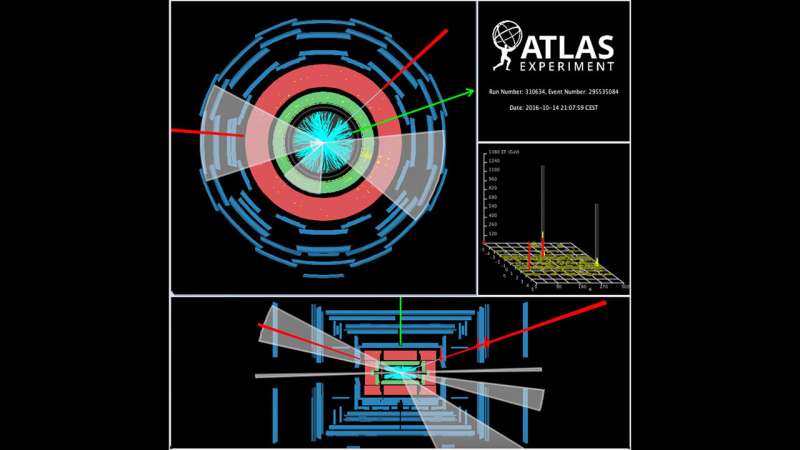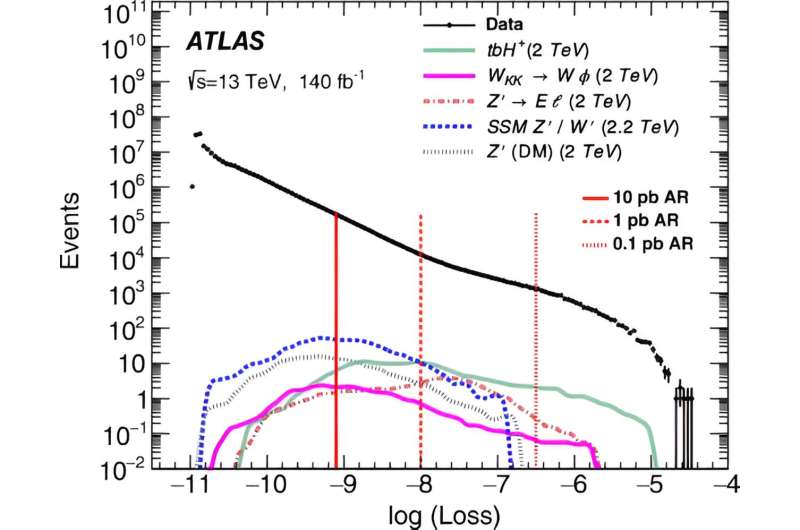Data and distribution of AE anomaly scores for five benchmark BSM models. Credit: Physical Review Letters (2024). DOI: 10.1103/PhysRevLett.132.081801
Scientists use neural networks, a type of machine learning algorithm inspired by the brain, to sift through large amounts of particle collision data. Particle physicists are tasked with mining large and ever-growing volumes of collision data for evidence of yet-to-be-discovered particles. In particular, they are looking for particles that are not included in the Standard Model of particle physics, and scientists suspect that our current understanding of the makeup of the universe is incomplete.
As part of the ATLAS collaboration, scientists at the U.S. Department of Energy’s (DOE) Argonne National Laboratory and colleagues recently used a machine learning method called anomaly detection to analyze large amounts of ATLAS data. This method has never before been applied to data from collider experiments. It has the potential to make collaboration more efficient in finding new things. The collaboration involves scientists from 172 research organizations.
The team used a brain-inspired machine learning algorithm called a neural network to search for unusual features or anomalies in the data. The technology disrupts traditional approaches to finding new physics. It is independent of, and therefore not limited by, the preconceptions of scientists.
Traditionally, ATLAS scientists have relied on theoretical models to help guide their experiments and analyzes toward the most promising discoveries. This often involves performing complex computer simulations to determine what certain aspects of the collision data will look like according to the Standard Model.
The scientists compared these Standard Model predictions with real data from ATLAS. They also compare them with predictions made by new physical models, such as those that try to explain dark matter and other phenomena not explained by the Standard Model.
But so far, no deviations from the Standard Model have been observed in the billions of collisions recorded by ATLAS. Since the discovery of the Higgs boson in 2012, the ATLAS experiment has not discovered any new particles.
“Anomaly detection is a very different way of doing this search,” said Sergei Chekanov, a physicist in Argonne’s High Energy Physics Division and lead author of the study. “Our goal is not to look for very specific deviations, but to find unusual features in completely unexplored data that may differ from our theoretical predictions.”
To perform such analysis, scientists represent each particle interaction in the data as an image similar to a QR code. The team then trained their neural network by exposing it to 1% of the images.

The ATLAS event showed one of the eight largest deviations from standard model predictions found by the neural network in this study.Image source: CERN
The network consists of approximately 2 million interconnected nodes, similar to neurons in the brain. Without human guidance or intervention, it identifies and remembers correlations between pixels in images that characterize standard model interactions. In other words, it learned to identify typical events that fit the predictions of standard models.
After training, scientists fed the remaining 99% of images into a neural network to detect any anomalies. When given an image as input, the neural network is tasked with recreating the image using its understanding of the entire data.
“If a neural network encounters something new or unusual, it gets confused and has a hard time reconstructing the image,” Chekanov said. “If there’s a big difference between the input image and the output it produces, it It will give us an idea that there might be something interesting to explore in this direction.”
Using computing resources at Argonne Laboratory’s Computational Resource Center, the neural network analyzed approximately 160 million events in LHC Run-2 data collected from 2015 to 2018.
Although the neural network found no clear signs of new physics in the data set, it did find an anomaly that scientists believe deserves further study. The decay of exotic particles with energies of about 4.8 teraelectronvolts produces jets of muons (a type of elementary particle) and other particles in a way that is inconsistent with neural networks’ understanding of Standard Model interactions.
“We have to investigate more,” Chekanov said. “It could be a statistical fluctuation, but it’s possible that this decay indicates the presence of undiscovered particles.”
The team plans to apply the technology to data collected during LHC Run-3, which begins in 2022.
Paper published in journal Physical Review Letters.
More information:
G. Aad et al., used unsupervised machine learning for anomaly detection using the ATLAS detector at s=13 TeV, searching for new phenomena in the two-body invariant mass distribution, Physical Review Letters (2024). DOI: 10.1103/PhysRevLett.132.081801
Provided by Argonne National Laboratory
citation: Machine learning could help reveal undiscovered particles in data from the Large Hadron Collider (2024, April 15) Retrieved April 20, 2024, from https://phys.org/news/2024 -04-machine-reveal-undiscovered-articles-large.
This document is protected by copyright. No part may be reproduced without written permission except in the interests of fair dealing for private study or research purposes. Content is for reference only.
#Machine #learning #reveal #undiscovered #particles #LHC #data
Image Source : phys.org
